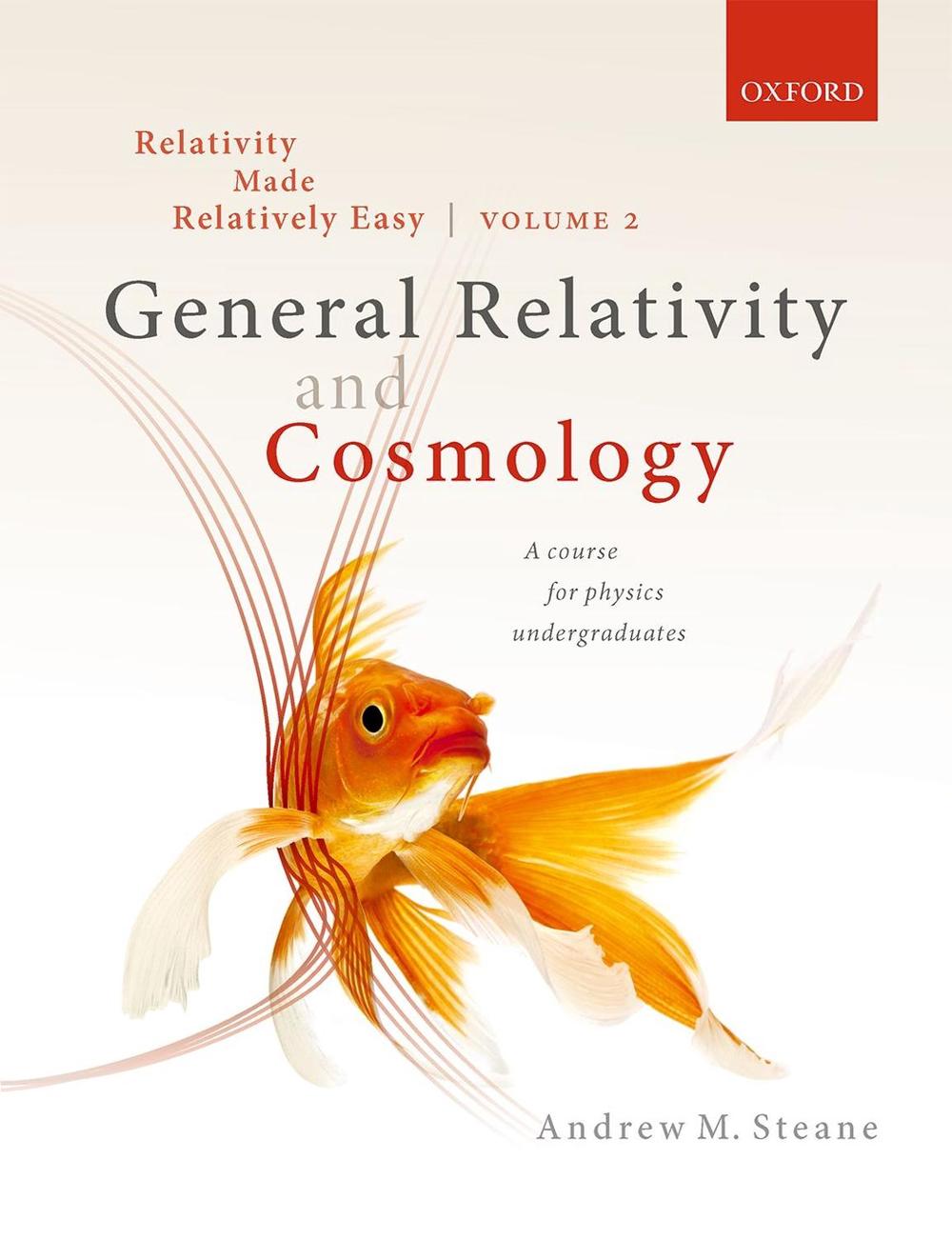
When you click on links to various merchants on this site and make a purchase, this can result in this site earning a commission. Affiliate programs and affiliations include, but are not limited to, the eBay Partner Network.
Relativity Made Relatively Easy Volume 2: General Relativity and Cosmology by An

- Item No : 365529619031
- Condition : Brand New
- Brand : No brand Info
- Seller : the_nile_uk_store
- Current Bid : US $83.09
-
* Item Description
-
The Nile on eBay

Relativity Made Relatively Easy Volume 2
by Andrew M. Steane
Aimed at advanced undergraduate or graduate physics students, the book aims to give a working understanding of astronomy and gravitational waves, as well as introducing the reader to the key concepts in cosmology and classical field theory.
FORMAT
PaperbackCONDITION
Brand New
Publisher Description
Following on from a previous volume on Special Relativity, Andrew Steane's second volume on General Relativity and Cosmology is aimed at advanced undergraduate or graduate students undertaking a physics course, and encourages them to expand their knowledge of Special Relativity. Beginning with a survey of the main ideas, the textbook goes on to give the methodological foundations to enable a working understanding of astronomy and gravitationalwaves (linearized approximation, differential geometry, covariant differentiation, physics in curved spacetime). It covers the generic properties of horizons and black holes, including Hawkingradiation, introduces the key concepts in cosmology and gives a grounding in classical field theory, including spinors and the Dirac equation, and a Lagrangian approach to General Relativity.The textbook is designed for self-study and is aimed throughout at clarity, physical insight, and simplicity, presenting explanations and derivations in full, and providing many explicit examples.
Author Biography
Andrew Steane is a Professor of Physics at the University of Oxford. He has conducted experimental and theoretical research into the foundations of physics and has performed pioneering quantum experiments with ultra-cold atomic clouds, as well as establishing the ion trap quantum computing program at Oxford. Professor Steane discovered quantum error correction and the CSS (Calderbank Shor Steane) codes and he is a recipient of the Maxwell Medal and Prize of theInstitute of Physics, and the Trotter Prize of Texas A&M University. He regularly lectures on relativity and other areas of physics and has published two undergraduate physics textbooks and two books onscience and religion with Oxford University Press.
Table of Contents
1: Preface2: Terminology and notation3: The elements of general relativity4: An introductory example: the uniform static field5: Life in a rotating world6: Linearized general relativity7: Slow stationary sources8: Gravitational waves9: Manifolds10: Vectors on manifolds11: The affine connection12: Further useful ideas13: Tensors14: Parallel transport and geodesics15: Physics in curved spacetime16: Curvature17: The Einstein field equation18: Schwarzschild-Droste solution19: Further spherically symmetric solutions20: Rotating bodies; the Kerr metric21: Black holes22: Black hole thermodynamics23: Cosmology24: Cosmological dynamics25: The growth of structure26: Observational cosmology27: The very early universe28: First steps in classical field theory29: Lagrangian mechanics for fields30: ConclusionFree
Review
Review from previous edition As Albert Einstein once emphasized, one should make things as simple as possible, but not simpler. Andrew Steane follows the master's recommendation and presents a relatively easy tour through the wonderful worlds of Special and General Relativity. He guides the reader patiently and pedagogically through the fundamental concepts as well as their main applications. This book is of great value for both students and lecturers. * Claus Kiefer, Institute for Theoretical Physics, University of Cologne *
Steane's book provides a physically oriented introduction to Special Relativity and its consequences, which does not compromise rigour in its exposition. I do not know of any other textbook on the topic covering such a breadth of topics at a detailed, but at the same time accessible and insightful level. In particular, the discussion of electromagnetism in the context of Special Relativity - where Relativity really comes into life - is excellent. The book contains an interesting and original selection of exercises which will help the dedicated reader to gain mastery in the details of the theory. * Juan A. Valiente Kroon, School of Mathematical Sciences, Queen Mary, University of London *
Offering a uniquely broad and thorough coverage of one of the standard tools of modern physics, Andrew Steane's Relativity Made Relatively Easy is an approachable and comprehensive coverage of Einstein's most famous contribution to science. It is sure to become a favorite resource for students and researchers alike. * Warren Anderson, Center for Gravitation and Cosmology, University of Wisconsin-Milwaukee *
The book truly has the potential to become a pivotal part of scholarship in physics. This lucid and thoughtful approach to taking the reader pedagogically through how Einsteinian relativity works, and how it supersedes the Newtonian construction with respect to explaining the basic principles of physical law, is comprehensive, thorough, innovative, challenging, and in many cases original. Steane's approach fills a gap in what in many university undergraduate courses has become a topic considered rather too briefly and in a rather too stereotyped manner, and which thereby has always denied physics graduates of the deeper insight into how Lorentz invariance is at the root of almost everything. * John Dainton, Sir James Chadwick Professor of Physics, University of Liverpool *Long Description
Following on from a previous volume on Special Relativity, Andrew Steane's second volume on General Relativity and Cosmology is aimed at advanced undergraduate or graduate students undertaking a physics course, and encourages them to expand their knowledge of Special Relativity. Beginning with a survey of the main ideas, the textbook goes on to give the methodological foundations to enable a working understanding of astronomy and gravitational waves (linearized approximation, differential geometry, covariant differentiation, physics in curved spacetime). It covers the generic properties of horizons and black holes, including Hawking radiation, introduces the key concepts in cosmology and gives a grounding in classical field theory, including spinors and the Diracequation, and a Lagrangian approach to General Relativity.The textbook is designed for self-study and is aimed throughout at clarity, physical insight, and simplicity, presenting explanations and derivations in full, and providing many explicit examples.
Review Quote
Review from previous edition As Albert Einstein once emphasized, one should make things as simple as possible, but not simpler. Andrew Steane follows the master's recommendation and presents a relatively easy tour through the wonderful worlds of Special and General Relativity. He guides the reader patiently and pedagogically through the fundamental concepts as well as their main applications. This book is of great value for both students and lecturers.
Feature
Includes chapters on gravitational waves and black holesFeatures a large number of processes and results derived in full as well as clear explanations designed to work for self-studyIncludes plenty of diagrams, exercises, and tutorial inserts to aid comprehension
Details
ISBN0192893548Pages 512Publisher Oxford University PressYear 2021ISBN-10 0192893548ISBN-13 9780192893543Format PaperbackImprint Oxford University PressPlace of Publication OxfordCountry of Publication United KingdomAuthor Andrew M. SteaneNZ Release Date 2021-11-02Publication Date 2021-11-02UK Release Date 2021-11-02Subtitle General Relativity and CosmologyBirth 1935Affiliation Professor of Physics, Department of Physics, University of OxfordPosition Professor of PhysicsQualifications PhDIllustrations 17 halftones, 89 line art illustrations, 3 combo illustrationsAlternative 9780192895646DEWEY 530.11Audience Tertiary & Higher EducationAU Release Date 2022-01-06


-
- The Lost Super Foods
- $ 37.00
- The Self-Sufficient Backyard
- $ 37.00
- A Navy Seals BUG IN GUIDE
- $ 39.00
- Childrens Books Phonics Lot 60
- $ 34.99
















